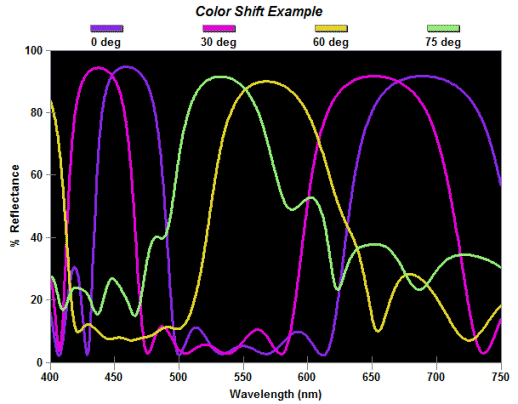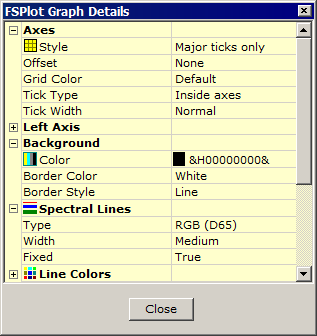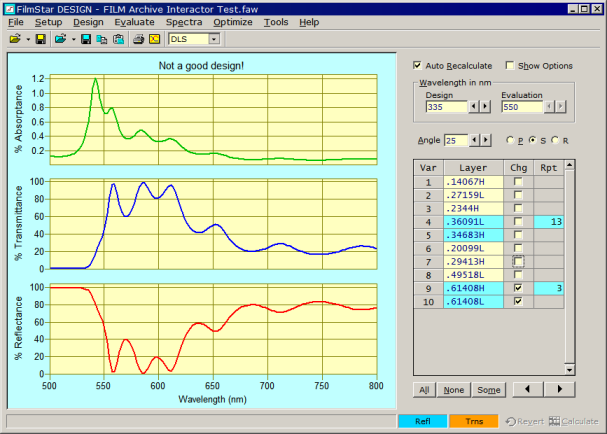Technical Issues - FilmStar News 2006
Other editions:
2007, 2008,
2009, 2010,
2011, 2012, 2013 January 6 Displaying Color Shift 1. Color Shift Filters...DESIGN now lets you select Spectral Line Type 'RGB' in the FSPlot Module. Plot line color then represents RGB colors corresponding to computed CIE coordinates (D65 illuminant). A black background is recommended.
This feature is useful for engineers developing color-shift coatings used in product identification, etc. These coatings (sometimes utilized in pigments) are more important than ever, especially in pharmaceutical packaging. The following macro generates the four plots at once:
If requested by users, this feature will be added to FilmStar MEASURE. 2. A new version of MEASURE adds Hitachi U-3210 and U-3410 (aka U-3200, U-3400). This replaces a previous 16-bit version which will no longer be available. Users of newer Hitachi instruments who would like to use FilmStar MEASURE are urged to complain to Hitachi about the lack of an RS-232 serial communications manual. It occurred to us that Microsoft Excel VBA can be used to set up FilmStar BASIC dialogs. This provides a better option for building dialogs with user-selected fonts and colors. In addition, it would be easier to develop complex interactive dialogs (using KeyPress and KeyDown events instead of FilmStar BASIC's Dialog Functions). Click here to learn more. March 7 Who Designed the Coating? A user with coating facilities in several countries asked that FILM Archive files include the designer's name. This has been implemented via NTFS (Windows 2000/XP/Vista/Windows 7) file properties. The File...Configuration...Directories dialog includes a new check box 'Enable file properties' under User Name. This adds NTFS Summary file properties to FILM Archive files as follows:
These properties can be viewed by right clicking on the file name in Windows Explorer, etc. Also, Last Author (modified by) is added, although this property is not displayed by Explorer. Checking 'Enable file properties' box activates the ability to edit and list file properties. Click here for further information. Supplementing the above, FilmStar BASIC Property UserName can now be used to set User Name, not just read it. This might be utilized in a log-on macro in a computer used by several film designers. Note: This entry was found to be in error and was revised 14 January 2010. April 21 PerkinElmer URA Support FilmStar MEASURE program mpe950.exe is now included in the FilmStar installer. This new version supports PE Lambda 650-950 with or without the URA (Universal Reflectance Accessory). It requires that UV WinLab (32-bit version) be installed on the same computer. You can handle the URA the FTG-way, or the PE-way. In the PE-way the 100% Reference scan (and 0% Baseline if selected) is automatic. Select 'Auto VN' under Reference in Scan Method screen 3A 'Measurement Type'. You then have a choice of Constant (assumes 0) or Scan for 0% Baseline. The problem with the PE-way is that you never see the 0% or 100% scan! Be sure to close UvWinLab before running FilmStar MEASURE. Program mpe983.exe continues to support HP (high performance) Lambda instruments without the URA and does not require UV WinLab. In this case there is no difference between selecting 800/850 or 900/950 models. WARNING: If you install Uv WinLab on a computer after installing FilmStar, it registers an older version of Report Generator support file vsPrint7.ocx. Reinstalling FilmStar or fixes this. May 17 New DESIGN Interactor New DESIGN 2.50 with Interactor! What's the Interactor? It's a whole new way to evaluate design changes.
Run DESIGN and click Evaluate...Interactor (or <Ctrl+Q>) to activate the Interactor. Up/down buttons let you quickly adjust layers, design wavelength, and angle. Layers can be changed individually or collectively. Holding down an arrow button changes values quickly; the <Ctrl> key speeds changes and the <Alt> key slows changes. The Interactor currently supports two modes: Design and Compare. Design allows up to 3 separate plots (plus RGB colors) while Compare lets you import (Spectra Open/Paste) a measured spectrum. You'll find further details in online help under Evaluate Menu. A user developing a Workbook model with many spectra, asked if it's possible to paste only R or T rather than both in the Workbook. This capability is implemented by setting DataType bit 3 (+8). Reviewing the settings for DataType: Name Value Description ---------- --------- ------------- Format Bit 0 (+1) Formatting enabled Loop Bit 1 (+2) Looping enabled Phase Bit 2 (+4) Phase values included when bit 0 = 0 One Column Bit 3 (+8) Paste one data column No Paste Bit 4 (+16) Suppress data auto-pasting PhaseSmooth Bit 6 (+64) Smooth phase column (radians) September 12 Polarizing Beam Splitters 1. A user evaluating polarizing beam splitters requested that the Interactor display multiple polarizations. In meeting this requirement, we added 3 new options under 'Pol Options' in the Interactor options box.
In addition, there is a new option under Scaling: Fixed 0-100%.
These options work when Setup Parameters is set to plot %R, %T, OD, or % Abs.
Some combinations are not allowed; for example you cannot overlap multiple plots
when both P and S are shown.
2. Here's a FilmStar BASIC macro for plotting Tp and Rs in the FSPlot Module:
October 16 BASIC Macros in Interactor 1. MEASURE for Lambda 900-950 - PbS Gain can now be programmed as a function of wavelength. This may be needed with fixed NIR slit width over a wide wavelength range. If slit width is not critical, unchecking Fixed under NIR Slit Width enables servo mode. Note that PbS gain settings are automatically adjusted in URA operation. Mpe983 & Mpe950 add the ability to scan sample beam or reference beam energy. This is enabled by clicking Setup... Data Type... Single Beam Mode. Explanatory tooltip text has been added to a number of buttons and text boxes. 2. DESIGN - Version 2.50.0700 adds Interactor-activated BASIC macros. This lets users display custom graphs and tables as the Interactor updates. The feature is accessed through the Automation tab in the Interactor options box. The BASIC code shown below displays average and maximum %R. ActiveX technology can be used to implement more complex requirements. ' **************************************************
' AveMax.bas displays average and maximum %R
' **************************************************
Option Explicit
Option Base 1
3. DESIGN - BASIC Sub GetRTData lets users export R and T values. This differs from Sub GetTableData which was intended for use with lens design software. GetTableData assumes 'FWD Ignore Side 2' mode, while GetRTData utilizes the current Side 2 setting. 4. DESIGN/INDEX - We recently helped a user determine n,k vs. wavelength for oxides. Since the %T data was noisy we could not use the peak & valley algorithm in INDEX. Instead we used LOREN and LORENK functions in DESIGN. This effectively averages out noise and gave very good results. The Interactor provided a fast way to deduce approximate film thickness before solving for thickness and index via DLS refinement. The procedure for transferring an Index Function from DESIGN to INDEX is as follows: Edit... Copy Function in the DESIGN Film Indices dialog followed by Edit... Paste Function in the INDEX Dispersive Index Functions (from main menu, Functions... Fit Index) dialog. (INDEX 2.41.0309 fixes a minor bug related to pasting functions.) October 29 Interactor Keyboard Commands 1. NTFS (NT/2000/XP) file properties have been updated; you can now add comments to FILM Archive and Index Table files. Comments are automatically updated without hitting File...Save. Click here for an explanation with screen shots. 2. The Interactor adds keyboard commands. Use the < > keys or - + numeric keypad keys to adjust values up and down. IF NO LAYERS ARE CHECKED, single layers move up and down when the layers grid has the focus; angle or wavelengths move up and down depending on which text box has the focus (contains a blinking cursor). This feature was added to simplify operation for technicians who need to correct color shifts. Layer selection is by up-down arrow keys, making it easy to vary individual layers without checking and unchecking boxes with the mouse. Note: the SHIFT key now slows changes (the ALT key did not work well with the keyboard) and (as before) the CTRL key speeds changes. This applies to up-down mouse buttons and the keyboard. December 7 Macro Command BasExec 1. A user in California wants to run a number of short FilmStar BASIC programs from a DESIGN Workbook macro. In order to simplify this, we added macro command BasExec. This lets you execute a BASIC program by including the code directly in the macro, instead of using BasRun with the macro file name. Since FilmStar BASIC requires program steps on different lines and macros are entered as a single line, the pipe character "|" is used as line separator. FilmStar automatically adds 'Sub Main' and 'End Sub'. FilmStar BASIC example
becomes macro command BasExec Dim a!|a=5|MsgBox "a=" & Cstr(a), 48, "It works!"; BasExec is intended for short code segments and is not intended to replace BasRun. You can test this facility by entering the macro in Tools... Macro Editor. 2. A user in India inadvertently discovered a bug in NTFS file properties. If file properties are enabled but the disk volume is FAT instead of NTFS, DESIGN crashes on opening or saving a file. While the simple fix (unchecking 'Enable file properties (NTFS)' in File Configuration Directories) worked, we realized that users transferring files from a USB stick or floppy would experience the same problem. The code has been modified accordingly and 'Not NTFS volume' is displayed in the File Properties dialog under those conditions. |
Copyright © 2023 FTG Software Associates
Last updated on
March 16, 2025


